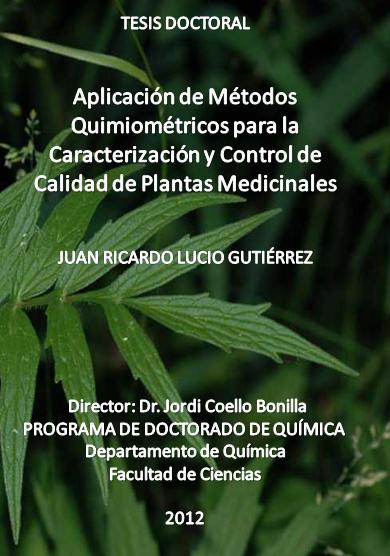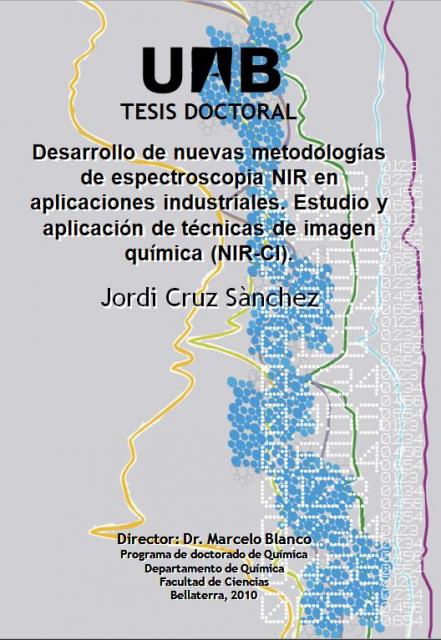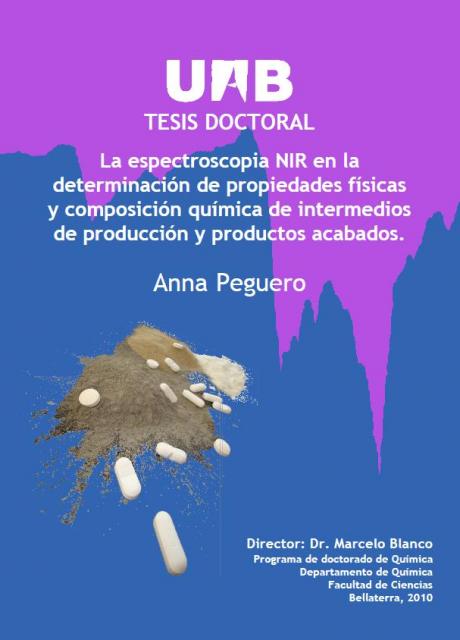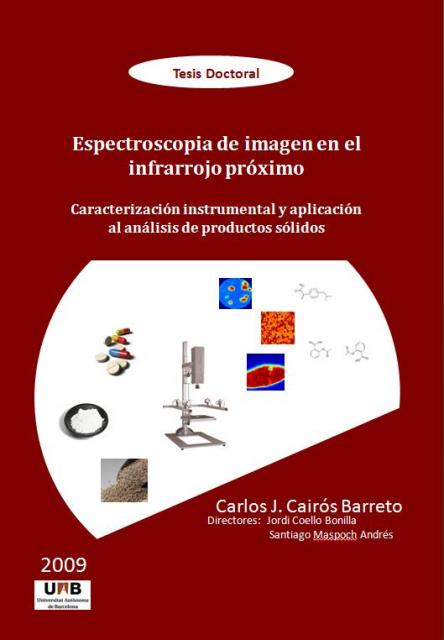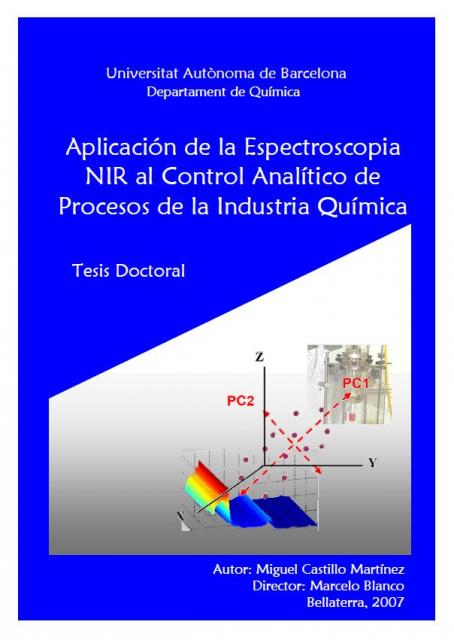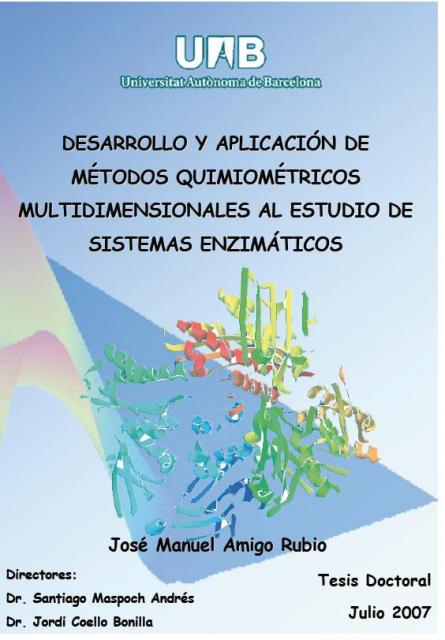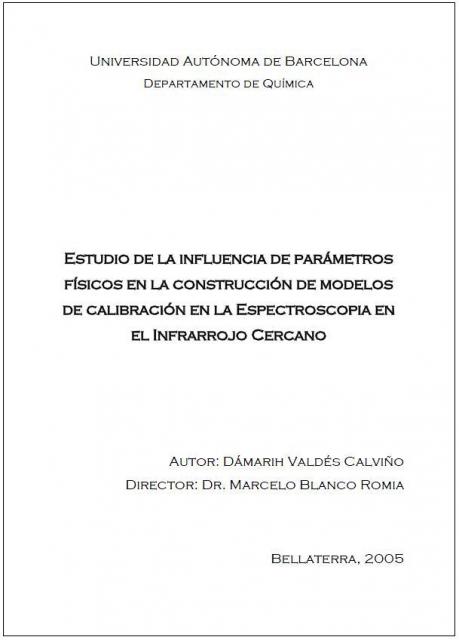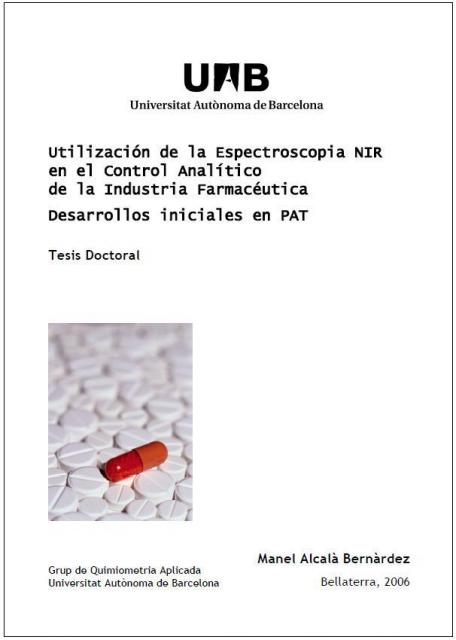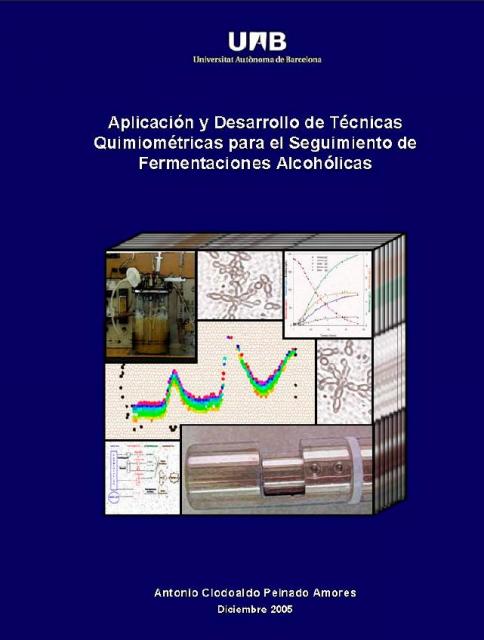----------------------------------------
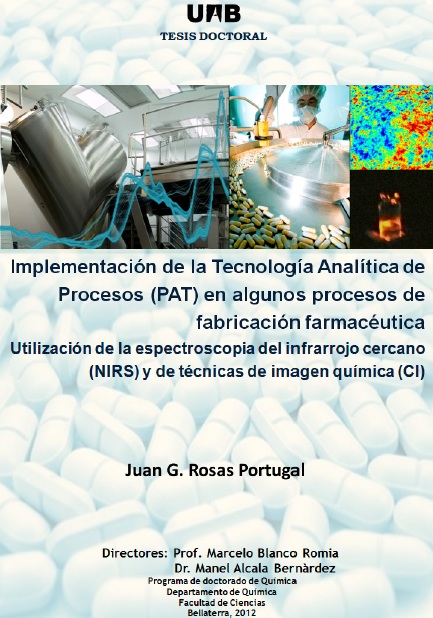
Juan G. Rosas Portugal - 2012
The pharmaceutical industry is subject to strict regulations, which intent to ensure the quality of the products offered on the market. This quality assurance is done by quality parameters determination through off-line test in the finished product. However, the complexity and variety of the methods delay significantly the release of the product with negative economic consequences and loss of competitiveness for the company.
As response to this situation, process analytical technology (PAT) and quality by design (QbD) initiatives emerged, which promotes the use of new technologies to ensure the quality of the finished products, controlling the different stages of manufacturing processes, allowing to obtain a better process understanding and consequently ensuring the quality of the finished product.
The diversity of quality parameter determinations conducted to NIR spectroscopy was recommended as one of the most appropriate tools for PAT. The advantages of NIR technique, versus other instrumental techniques, make it as ideal tool for these analytical needs (e.g. no sample preparation, no need for reagents, easy and fast acquisition of results).
The studies presented in this Doctoral Thesis are aimed to propose and provide solutions to the continuous improvement of quality in pharmaceutical processes. For this reason multivariate NIR calibration models were constructed to determine the critical quality attributes (CQAs) in both intermediate and finished product. The selected CQAs for a granulate formulation were the active pharmaceutical ingredient (API) content, moisture, pH, particle size and flow properties. These models have been implemented in the manufacturing process by the company by using non-invasively and real-time NIR measurements in a non-qualified area. This strategy represents a tremendous savings in time and a considerable improvement in productivity. In another study concerning a blending process of pellets, it has been developed a new mathematical method to determine in real time the blend homogeneity during blending process and a NIR method for quantifying an API. A interesting feature of this study was that we used a wireless NIR equipment, remotely controlled, allowing the spectrophotometer forms part of the process.
A full study, planned and executed, based on QbD philosophy for a manufacturing process of pharmaceutical gel was performed. In this study, the process variables were defined and the design space (DS) of process was assesed. The constructed NIR methods allow to determine the CQAs throughout manufacturing process, such as viscosity, pH, and API content. These determinations during the process allow to assure that system will maintain within DS.
The suitability of the NIR Spectroscopy for the in-line monitoring of a multicomponent mixture freeze drying process has been evaluated. In this study different chemometric methods allowing to extract useful information of process by means of NIR measures were assessed.
Finally, appropriate algorithms have been developed to extract information about the homogeneous distribution of components in an image (e.g. digital or hyperspectral). These methods informing about the homogeneity of solid pharmaceutical samples solid, such as coated tablets, cores, effervescent tablets and powder blends; therefore, chemical image techniques have been proposed for the establishment of the homogeneity of solid samples.
These studies have demonstrated that NIR spectroscopy and chemical image techniques are adequate tools for the process analytical technology in the pharmaceutical industry.
----------------------------------------
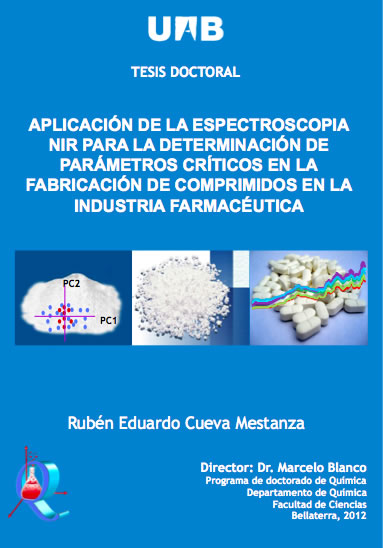
Rubén Cueva Mestanza - 2012
The pharmaceutical industry needs to have fast and reliable analytical methods for efficiently controlling each of the different stages of production, from raw materials, intermediate products to finished products. The emergence of the initiative Process Analytical Technology (PAT) has promoted the introduction of modern spectroscopic techniques for monitoring the manufacturing process aimed at determining critical quality parameters that lead to a better understanding of the product and towards continuous improvement.
With the goal of propose new methodologies that are real alternatives to conventional methods and also achieve a real advance in the implementation of PAT, in this thesis we study the application of NIR spectroscopy to determine the parameters of interest in the manufacturing process of tablets for the pharmaceutical industry. The stages in the production of tablets which were studied are mixing, granulation and the analysis of parameters of interest of the final tablets.
Two critical studies of different qualitative and quantitative methods applicable to the mixing process monitoring were performed in order to choose the best method for detecting the end point of mixing. Different algorithms are studied to be applied to the spectra recorded during the mixing to obtain an end point of mixing, at the same time ensures the uniformity of dosing in the final tablet. The first study was conducted using NIR spectroscopy. The second is a comparative study of the results using the NIR spectra versus Raman. We show that some of the procedures described in the literature are not suitable for this purpose, while other procedures, which are simple and easy to develop, provide good results and are desirable for this application.
An additional study is the particle size estimation, which is an important parameter to ensure the proper fluidity of a granulate. This study was expanded with the determination of the active principle in granular intermediate process and in the final product. Finally, we have established a method for the determination of the compaction pressure of the tablets.
This compaction property is important for its influence on the dissolution test that will determine that the product can be released to the market. The determination of the concentration of active principle (API) in the final tablets aims to ensure compliance with specifications, this method has been validated following the ICH guidelines and EMA, allowing its application in analytical control of the finished product in the production process.
We have studied the development and optimization of a new methodology to develop calibration models that incorporate physical variability produced during the manufacturing process of each formulation. This method consists in adding a set of process spectra (spectra obtained by the difference between the spectra of production tablets and laboratory samples with the same nominal concentration) to the set of samples prepared in the laboratory as a way to incorporate the physical changes during each stage in the production process of the tablets.
The methodologies developed in this thesis provide solutions to real situations in the pharmaceutical industry and have successfully demonstrated the ways that NIR spectroscopy can be a suitable tool for controlling physical and chemical parameters within the tablet manufacturing process, obtaining thus adequate predictive capabilities
.
----------------------------------------
Application of Chemometric Methods for the Characterization and Quality Control of Medicinal Herbs
Ricardo Lucio Gutiérrez - 2012
This thesis deals with the application of chemometric methods for quality control; four medicinal plants for which there are reports of confusion, adulteration or presentation of adverse reactions in consumers have been studied. Chapter one is a general introduction and Chapter two presents the objectives. Chapter three studies E. senticosus, a member of the Araliaceae family. A near-infrared spectroscopic procedure to obtain a fingerprint of E. senticosus has been developed using raw materials. The spectra were processed by using different pattern recognition procedures. General classification success rates (GSR) of 84% and 92% were achieved by Soft Independent Modeling of Class Analogy (SIMCA) and Partial Least Squares Discriminant Analysis (PLS-DA), respectively. Tests on laboratory-made mixtures showed that it is possible to detect adulterations or counterfeits with about 5% foreign herbal material, depending on their closeness to the Araliaceae family. The sensitivity and specificity of constructed models were above 73%. Chapter four is about P. ginseng; proper identification, mixture detection and semi-quantitative determination of binary mixtures have been achieved using near-infrared spectroscopy and chemometrics. Raw NIR spectra were normalized and the classification ability of three different pattern recognition procedures was assayed. SIMCA, PLS-DA and discriminant analysis reached equal sensitivity value (100%); however, SIMCA obtained the best GSR (95%) and had the higher specificity (100%) and ability to detect debased samples (80%). Moreover, the semi-quantification of mixtures performed with multivariate curve resolution presented a mean percent error of 5.53% and showed that mixture composition should change in amounts larger than 3.64% in order to retrieve proper results. Chapter five describes a strategy for multi-wavelength chromatographic fingerprinting of herbal materials, using high performance liquid chromatography with a UV-Vis diode array detector. Valeriana officinalis was selected to show the proposed methodology. The enhanced fingerprints were constructed by compiling into a single data vector the chromatograms from four wavelengths (226, 254, 280 and 326 nm), those where characteristic chemical constituents of valerian presented maximum absorbance. Chromatographic data pretreatment included baseline correction, normalization and correlation optimized warping. The GSR values achieved by SIMCA and PLS-DA were above 90%. The sensitivity and specificity of constructed models were above 94%. Tests on laboratory-made mixtures showed that it is possible to detect adulterations or counterfeits with 5% foreign herbal material, even if it is from the Valerianaceae family. Chapter six deals with the implementation of the enhanced fingerprint strategy together with PLS regression, in order to improve the prediction of the antioxidant activity of Turnera diffusa. The wavelengths were selected from a contour plot, in order to obtain the greater number of peaks at each of the wavelengths (216, 238, 254 and 345 nm). A PLSR model with four latent variables explained 52.5% of X variance and 98.4% of Y, with a root mean square error for cross validation of 6.02. To evaluate its reliability, it was applied to an external prediction set, retrieving a relative standard error for prediction of 7.8%. The study of the most important variables for the regression indicated the chromatographic peaks related to antioxidant activity at the used wavelengths. Chapter seven presents the overall conclusions drawn from the quality control methods proposed for the four medicinal plants studied and Chapter eight describes several possibilities for further research. Finally, the appendix lists the publications resulting from the work carried out.
----------------------------------------
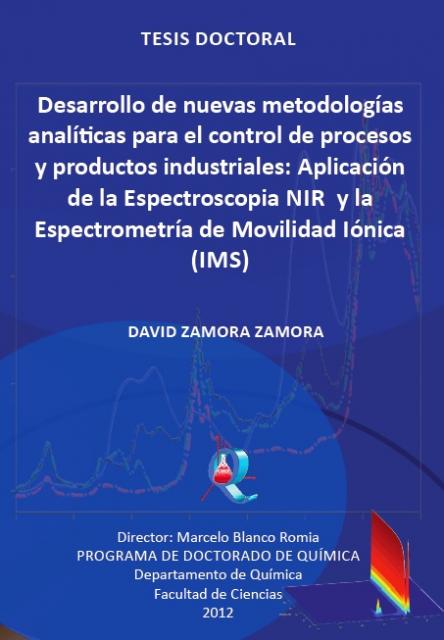
David Zamora Zamora - 2012
The industry, and particularly chemistry and pharmaceuticals, needs to improve the efficiency of production processes to ensure obtaining the products in high quality while reducing consumption, what will result in improving productivity. This demand requires the development of analytical methodologies in simple, fast, reliable and low cost manner, which can be used in routine and by unskilled labor, which enable to track the entire production process, and if necessary, apply corrective actions, to obtain high quality products. In order to provide the industry these new methods of analysis to achieve these objectives, in this thesis there have been carried out several studies based on NIR spectroscopy and ion mobility spectrometry (IMS).
In the first study of the thesis, NIR spectroscopy has been applied for in-line monitoring of enzymatic esterification process of glycerol with stearic acid in the presence of a lipase from Candida Antarctica, with a NIR immersion probe in the reactor. In the processes performed, the enzymatic reaction leads to the formation of glycol distearate and glycerol monostearate; not being observed the formation of tristearate. It has been developed PLS calibration models for each of the components, using the spectra recorded and the values obtained by gel permeation chromatography; the models were simple and had a correct prediction.
The developed methods have been applied to monitoring processes, obtaining results that demonstrate the usefulness of NIR in-line monitoring of the enzymatic esterification reaction studied.
The next study involved the development of a NIR method for determining components of a mixture adjuvant in an herbicide product, which was applied for spraying a suspension. The great similarity of the components spectra has required the implementation of an experimental design for sample preparation, which aim is to ensure robustness of the calibration model. The application of the models built to samples of production batches showed good predictive ability of the models constructed, and their utility for checking the composition of such mixtures.
In a third work, spectral libraries were developed for the identification of lubricant formulations, which had very similar spectra. The developed method based on the construction of libraries or sub-cascading libraries, ensures the necessary specificity for discrimination between products that were unambiguously identified in the general library. Using more stringent criteria of differentiation, the library allows the differentiation between lubricant formulations which contain or not additives in a relatively small amount (0.05 to 0.7%). In this work, PLS models were also constructed for the determination of composition and viscosity of lubricants.
In the present thesis, we have developed analytical methods using IMS technique for the first time in our research group, in order to complement some analytical issues that cannot be resolved by NIR and that are amenable to IMS. This is a new technique that has been rarely used in the chemical and pharmaceutical industries. There have been studied, developed and validated two new analytical methods for determination of residual amine during the manufacturing process of amidoamines and phospholipids, and one for the determination of two active principles ingredients (in low concentration) of a pharmaceutical preparation. In both cases, we have studied the influence of instrumental factors in the IMS response and we have performed an optimization of the quantification method to get the best instrumental response and sensitivity. Multivariate models were constructed which allowed the determination of the species of interest. The developed methods have been applied to analytical control of the preparations studied.
----------------------------------------
Jordi Cruz Sanchez - 2010
The obtaining of the highest quality products is a challenge in the modern industry with increasingly importance. These products should satisfy the user, but also accomply the strict regulations before the marketing. NIR spectroscopy is a technique recently introduced that has several advantages over other techniques: non invasive, non destructive, fast, low cost and environmentalfriendly.
These advantages have increased its application in different industrial fields. In this thesis, the application of NIR spectroscopy for the determination of parameters of interest in the manufacture of polyester resins has been performed and, additionally, a new calibration method for the determination of API in samples from different production stages have been proposed for the pharmaceutical field. The main goal has been provide new methodologies that can be summarized as rapid and effective alternatives to conventional methods that allow a quality control of the manufactured products. NIR chemical imaging (NIR-CI) is a technique of increasing interest in the analysis of pharmaceutical products and represents a versatile complement to conventional NIR spectroscopy.
Different studies have been done to increase and improve the knowledge of the samples assessing the compliance of the quality demands in pharmaceutical analysis. Direct analysis of the sample by using imaging techniques provides a NIR spectrum for each pixel of the image, and by appropriate chemometric treatment of the large amount of information, different results can be achieved, such as the determination of API and excipients of single or multiple tablets only by the obtaining of a single image.
Moreover, a methodology based on NIR-CI and Multivariate Curve Resolution - Alternating Least Squares (MCR-ALS) algorithm is proposed for the quantitative analysis of acetylsalicylic acid tablets of different commercial brands. The composition information was obtained from the Vademecum. This algorithm does not require defining a calibration model and it does not need reference values. It only needs the spectra of the pure components of the formulation. The capability of the methodology has been demonstrated through the accurate quantification of API and also providing information about the spatial distribution in the tablet surface, using the concentration histograms. 10 different commercial brands have been studied and, in all the cases, the obtained results are in accordance with the specifications of the drug.
An extension of the previous study has been done. The appropriate methodology has been developed in order to establish the API and major excipient distribution homogeneity. The determination of content uniformity (defined by the European Pharmacopoeia) is established from Acceptance Value (AV) by quantifying the individual value of each tablet of a single hyperspectral image of 10 tablets. This determination is essential to release a production batch to the market and represents a significant time saving compared to conventional methods.
It has been performed a comparative study of the two used software Isys-PLS1 (an algorithm that commercial software called PLS1 Malvern Isys 5.0) and MCR-ALS for the determination of API and excipients in hyperspectral images, in order to select the most suitable for its application to future studies. The results indicate that both are equally valid for this purpose because the results do not differ significantly.
The obtained results from the studies of commercial tablets of aspirin have been applied to a formulation during the development stage. The concentration and distribution of API and excipients in tablets with different coating thickness have been quantitatively determined. Initially, the information extracted from hyperspectral images has been analyzed with Isys-PLS1, that allowed to determine the concentration and the uniformity of distribution of all constituents of the drug. Moreover, PLS1 model was created with the mean spectra of different coating thickness tablet images. Applying this PLS1 model to production tablets the coating thickness and its distribution in the tablets can be determined.
The applications based on hyperspectral imaging have allowed us to achieve the initial objectives and to establish effective strategies for improving the quality of products of both the chemical and pharmaceutical industry using NIR spectroscopy.
----------------------------------------
Anna Peguero Gutierrez - 2010
Obtaining a high quality final product constitutes a challenge with increase importance in the modern industry. The products should fulfil strict specifications established by regulatory agency just before their releasing to the market. Several new methods based on NIR spectroscopy have been developed for the industry in order to provide the optimum tools to achieve these objectives. This PhD Thesis provides the analytical knowledge to solve real industrial problems usually present in the mortar and pharmaceutical industries. Two studies have been conducted for the cement industry, with the aim of improving the value of the final product. Firstly, quantitative calibration models for additives in mortars have been developed. In order to ensure the calibration set contain natural variability of the samples, we used an experimental design to select the best representative set of samples. This novel approach is based on a hexagonal antiprism that encompasses the concentration ranges spanned by the analytes and the natural variability inherent of each additive. The D-optimality criterion has been used to obtain several combinations between additive classes. The PLS calibration models thus constructed for each additive provided accurate predictions. The ensuing analytical methods have been validated using an external sample set. Secondly, particle size distribution is a key quality attribute of mortars.
Different approaches have been carried out to quantify this distribution in mortars. Two different profiles of particle size distribution have been studied and PLS2 and ANN calibration models have been calculated for each one. The objective has been to achieve the best predictive ability of the calibration models in terms of high correlation coefficient between the reference and predicted distribution curve and low prediction errors. The results obtained with the four calibration models were not statistically different. Therefore, the combined use of NIR spectroscopy and PLS2 or ANN calibration models allowed an accurately determination of particle size distribution in mortars. The use ANN for non-linear modelling of the data set has not improved the results. In the pharmaceutical field, the studies have been conducted to the determination of API at different stages of the manufacturing process and also in the final product. The main link of the following works is the development of calibration models without using reference method for determining the dependent variable. In the first work, the API concentration has been quantified throughout the entire production process of a pharmaceutical formulation. The authors have evaluated the influence of particle size, galenic form, compaction pressure and coating thickness on the NIR spectra of the sample. The eventual influence of these variables was included in the calibration model in a simple way that allowed the accurate and precise prediction of the API at the different stages of the production process.
In the second and third work, a new methodology has been developed to construct calibration sets. This methodology is based on obtaining the process spectra, which is calculated by the difference between the NIR spectra for production tablets and those for laboratory samples containing the nominal concentrations of API and excipients. The body of differences thus calculated for several tablets constitutes a set of mathematical vectors that define the overall variability of the process. This new matrix is added to a set of NIR spectra for several powder mixtures spanning the desired content range for the API and excipients in order to obtain the spectral matrix for the calibration set. Applying PLS algorithm to calibration set allows constructing of calibration models for each analyte. This methodology has been applied successfully on API and excipients determination in commercial pharmaceutical tablets. In this way, tablet contents can be predicted with errors less than 1.5%.
--------------------------------------
Carlos Cairós Barreto - 2009
La espectroscopia de imagen en el infrarrojo cercano (NIR-CI) combina la espectroscopia convencional con el tratamiento de imagen digital. La información espectral y espacial se registra simultáneamente proporcionando un espectro NIR por cada pixel de la imagen de la muestra. La característica más importante de esta técnica es que, además de la identificación y cuantificación de componentes químicos presentes en la muestra, se obtiene simultáneamente su distribución espacial y el tamaño y forma de agregados dentro de la misma, información que se puede relacionar con la calidad del producto.
Los productos solidos estudiados están en el ámbito de la industria farmacéutica, la cual está estrechamente regulada. Los procesos de manufactura han sido tradicionalmente procesos poco flexibles y su control de calidad basado principalmente en el estudio de los productos finales. La complejidad que implicaba cualquier pequeño cambio, llevo a un cierto estancamiento y a un retraso en la incorporación al proceso productivo de innovaciones científicas y metodológicas. Con el propósito de mejorar tanto el conocimiento del proceso como su calidad y, obviamente, mejorar la garantía de la calidad del producto final, la administración de drogas y alimentación de los Estados Unidos (FDA) público un texto guía sobre el uso de la tecnología de control de procesos analíticos (PAT).
El concepto PAT incide en la necesidad de controlar la calidad en todos los puntos del proceso, es decir la calidad en el diseño (Quality by Desing, QbD) como alternativa a evaluar únicamente la calidad de los productos terminados. NIR-CI es una de las nuevas técnicas analíticas promovida por la iniciativa PAT para obtener un mejor entendimiento de los procesos y también para ser utilizada para el control de procesos.
Esta tesis tiene como objetivo principal la evaluación de una cámara de imagen en el infrarrojo cercano y su aplicación al análisis de productos farmacéuticos sólidos. La cámara está dotada de un sistema modulable de selección de longitudes de onda que permite registrar el espectro NIR en cada pixel de la imagen. Dado que, en cada imagen, se obtiene un enorme volumen de datos con estructura tridimensional, se necesita desarrollar métodos quimiometricos que permitan extraer el máximo de información.
La imagen NIR, como cualquier otra imagen, se obtiene normalmente en modo reflectancia difusa, y por tanto, se obtiene información tanto química como física de la muestra, información que se encuentra muy correlacionada, y que hace que la señal obtenida sea difícil de interpretar. Por esto, el proyecto contempla una primera fase en la que se realiza el estudio sistemático del efecto del tamaño de partícula sobre el espectro. Para ello se ha aplicado la teoría de la capa representativa, de nueva aparición, desarrollada por Dahm & Dahm en el año 1999. Esta teoría no había sido aplicada a muestras solidas reales. En la tesis se ha estudiado un producto que presenta absorción en NIR (hidrogenoftalato de potasio) y otro que no absorbe (cloruro de sodio) y cuyo efecto principal es contribuir a la dispersión de la radiación en la absorción en NIR de la humedad que contiene. Se estudio la influencia en los espectros del tamaño de partícula (50-500 μm).
La radiación NIR tiene la capacidad de penetrar en una muestra solida de una forma significativa, adquiriendo información importante de la muestra. Esta es una de las características que hace especialmente útil a la radiación NIR para el estudio de sólidos, ya que se puede obtener información química de una forma no invasiva ni destructiva, de una cantidad de muestra relativamente grande, que no podría ser analizada de esta forma por ninguna otra técnica espectroscópica. En reflectancia difusa, los detectores registran la información obtenida de una cierta cantidad de muestra que es desconocida y que depende de diversos factores físicos y del poder de absorción de la muestra3. En esta tesis se ha realizado un estudio de la penetración de la radiación NIR en los dos productos mencionados anteriormente. Para cada longitud de onda, se ha estudiado el efecto del tamaño de partícula y del grado de absorción del producto en la penetración de la radiación. En este trabajo, por primera vez, los valores obtenidos experimentalmente se han comparado con los estimados a partir de la teoría de Dahm.
Existen tres tipos de resolución en una imagen química, la resolución óptica del aparato, la resolución del espectral y la resolución química. Ligado a la evaluación de la cámara NIR, se ha estudiado su resolución química, es decir, que cantidad de muestra contribuye a la medida que es registrada en una determinada superficie (pixel), o dicho con otras palabras, el grado de contaminación del espectro de un pixel por material de los pixeles vecinos. Para ello se ha estudiado la frontera entre distintos materiales puros (polímeros y materiales en polvo)4. El resultado se ha comparado con el obtenido con un instrumento comercial distribuido por Malvern S.L. Se ha estudiado la variación de la resolución con la absorción específica a cada longitud de onda y con las características de dispersión de la muestra.
En la actualidad existen muy pocas aplicaciones informáticas específicas para el tratamiento de imagen NIR5. Además, estas suelen ser muy cerradas a la hora de ofrecer información al usuario de los algoritmos o funciones estadísticas o matemáticas que utilizan y, por otro lado, significan una inversión económica importante. La tendencia general es utilizar por separado algún software de tratamiento de imagen que permita realizar el desdoblamiento de la matriz tridimensional de datos y utilizar posteriormente algún software específico para el tratamiento de espectros NIR. Por lo tanto, de forma paralela a la puesta en marcha y evaluación del prototipo, se ha llevado a cabo el desarrollo de algunas herramientas para el tratamiento de datos obtenidos en NIR-CI. Estas herramientas han sido elaboradas en forma de rutinas programadas para ser ejecutadas en MatLab, dado que
el programa de adquisición del prototipo genera una matriz de datos que puede abrirse directamente en dicho software. Se ha desarrollado una metodología para obtener información a partir de una imagen (o conjunto de imágenes) sin disponer de ninguna información previa sobre ella, a través del uso de coeficientes de correlación, análisis de componentes principales (PCA) y la aplicación de una función, propuesta específicamente para mapas de coeficientes de correlación, que sirve para mejorar el contraste de los mapas. La segunda aplicación caracteriza el grado de uniformidad en muestras solidas utilizando imagen NIR y análisis de macro-pixel.
Como resultado de los trabajos que conforman esta tesis se han publicado, hasta el momento, dos artículos, que han sido incluidos en la sección de anexos y que corresponden con los estudios detallados en el capítulo 4 (anexo 3) y capitulo 7 (anexo 4). Actualmente se está trabajando para la publicación de otros artículos, que incluirán los contenidos descritos en los capítulos 6 y 8.
--------------------------------------
Manel Bautista Mercader - 2009
Pharmaceutical production aims to provide a drug that meets strict quality conditions that ensure user satisfaction. This is a complex and varied procedure constituted by different phases. Quality assurance of final product can be achieved through a continuous control in the different stages, which require the application of different instrumental techniques capable of determining not only the chemical composition of the preparations but also for intermediate physical characteristics of them. These determinations consume considerable time reducing the productivity. This has led to the Food and Drug Administration (FDA) to promote an initiative, Process Analytical Technology (PAT), which aims to incorporate new technologies to the production process to provide a better and wider knowledge of the production process, reducing the time control and increase productivity.
A wide variety of instrumental techniques capable of providing solutions to this challenge have been proposed, but certainly the NIR spectroscopy is the most appropriate technique for their characteristics such as speed,
no sample preparation, determination of composition and physical properties, ease incorporation of the productive process, and so on. In order to improve various stages associated with pharmaceutical production processes to ensure the final quality of the drug and also intermediate stages of the process, we have approached the study of the application of NIR in some situations of interest to the manufacturing process through implementing systems to conventional NIR spectroscopy and imaging techniques Chemical latest deployment The objective of this thesis is to develop new applications of NIR spectroscopy that may be interesting in the production process in order to broaden awareness of it and that can improve the quality of the final product as the manufacturing process. The ultimate aim consists in applying these developed methodologies in the production process, either in control or in the intermediate stages of the finished product, which will be the demonstration that it has met its objectives.
----------------------------------------
Aplicación de la espectroscopia NIR al control analítico de procesos industriales
Miguel Castillo Martín - 2007
The aim of this work is the application of Near-Infrared Spectroscopy (NIR) to chemical process control, developing methods that allow the analytical control of the reaction parameters and/or the follow-up of the compounds involved in the reaction. For such an aim, different chemometrical tools have been applied, standing out between them, PCA (Principal Component Analysis), PLS (Partial Least Squares) and MCR-ALS (Multivariate Curve Resolution-Alternating Least Squares).
One reaction with industrial interest is the esterificación of glycerine with medium and long chain fatty acids that gives a wide variety of products, according to the nature of the acids and the proportions of acid/glycerine, which give place to mixtures of mono-, di- and triglycerides in different proportions. In this thesis, the esterification between glycerine and a mixture of caprilyc and capric acids to obtain a triglyceride has been studied. The process is frequently controlled by using titration methods such as the Acid Value (AV) and the Hydroxyl Value (OHV), which are time-consuming, need the use of toxic reagents and solvents, and give poor information.
To replace these methodologies, calibration models were build with the NIR spectra of the samples and the respectively reference values. The samples were obtained from laboratory and industrial scale esterification processes, being the NIR spectrum registered at-line. PLS1 calibration models were built for OHV, AV and water content, being the results obtained by NIR comparable to the provided ones by the reference methods, which allow the rapid control of these three parameters departing only from the NIR spectrum.
When the above reaction is done with an excess of glycerine, the obtained product it is a mixture of mono-, di- and triglycerides, and its composition is determinant to assure that the product will reach the pre-established specifications. In that case, it is interesting the construction of a PLS model for each of the compounds involved in the reaction. For this aim, samples were extracted from industrial and laboratory scale processes, and doped samples were prepared in order to reduce the concentration correlation between the different target compounds. NIR spectra were registered at-line, and the samples were analyzed by gas chromatography for to obtain the reference concentrations. PLS1 models were built for each component, which allow the determination of all the species involved in the reaction with only the spectrum NIR, reducing the time of analysis in comparison to other instrumental techniques. The results obtained in the validation of the PLS models show that the quality of the models is adapted and sufficiently for the at-line control of the reaction, and allow to act on the process for its control.
This esterification process (esterification with a glycerine excess) was studied later by Multivariate Curve Resolution (MCR-ALS) with the aim to know the capacity of this technique for the study of reaction processes. The system studied, the spectra corresponding to the process realized with excess of glycerine, turned out to be a rank deficient system. In order to solve the rank deficiency, it was studied the use of equality constraints in the iterative process by the incorporation of the concentration profiles of the chemical species involved in the reaction; this strategy allowed to obtain the pure spectra of them. This way, the spectra of chemical species not available in high purity were obtained by MCR-ALS. These spectra were used later for the estimation of the concentration profiles in new processes; this form, less reference information is required in comparison to the construction of a PLS model, which supposes an advantage for the development of calibration models and for the study of reaction processes.
Subsequently, the reaction to obtain a triglyceride was studied. In this case, the rank deficiency was solved augmenting the data matrix with the pure spectra of the components involved in the reaction, being also used as initial estimations in the iterative process, and including a minimum of quantitative information as equality constraints. The concentration profiles obtained allow establishing the evolution of the species and, subsequently, to calculate the AV and OHV values in new samples. MCR-ALS results for the prediction of external samples are comparable to the obtained ones for PLS in terms of RSEC/P'%, with the important advantage that MCR needs less reference information.
A similar methodology was applied in the study by in-line near-infrared spectroscopy of the esterification reaction between myristic acid and isopropanol, the latter being added continuously. The aim was the obtaining of the concentration profiles by MCR-ALS without the need to resort to analytical reference data. Similarly to the previous study, the rank deficiency was solved by adding to data matrix the pure spectra of the components involved in the reaction; thus, the concentration profiles were obtained departing only from spectral NIR information. The concentration profiles obtained were used for the calculation of kinetic constants, establishing that the reaction is pseudo-first order, that the kinetics of the reaction depends on the speed of the addition of isopropanol, and also, in the water content of this one. The NIR-MCR proposed method allows determining the influence of experimental parameters in a rapid and effective way, without the need of reference analysis.
Finally, NIR spectroscopy was used in combination with PLS calibration for the determination of low analyte concentrations, applied to a purification process: the elimination of 2-etilhexanol by distillation. The effect of two spectral pretreatments, OSC (Orthogonal Signal Correction) and NAS (Net Analyte Signal), was studied for the determination of concentrations near the detection limit. Both methods have a high capacity to reduce the NIR signal not correlated with the analyte concentration, allowing the reduction of the number of factors necessary to construct the PLS model. Nevertheless, both pretreatments do not improve the prediction results with external samples in terms of RSE%. This study has been completed by the application of two methodologies for the estimation of the detection limit of the PLS model: the first is based in the estimation of the prediction variance of the PLS model; the second is an adaptation of the univariate methodology proposed by the ISO. Both methodologies allow the estimation of the detection limit in multivariate calibration models in a simple form; and confirm that OSC and NAS do not improve the detection limit. The PLS model obtained allows monitoring the distillation process, stopping the process once the specified concentration is reached, avoiding to apply a time-out in the distillation that provokes a deterioration of the sensory properties of the final product.
--------------------------------------
José Manuel Amigo Rubio - 2007
The main objective of this dissertation is the application of multidimensional chemometric methodologies to the kinetic analysis of enzymatic reactions. These enzymatic reactions have importance in analytical chemistry and in fermentation processes at industrial scale. This principal objective may be split into several partial objectives:
1) The study of reactions related with the catalysis of mixtures of hypoxanthine, xanthine and uric acid with xanthine oxidase with the aim of studying the reaction mechanism in biological matrices and to calculate the enzymatic constants in complex reactions. In addition, the influence of the reaction media in the enzymatic mechanism will be studied in a controlled media and in human urine. Another objective is the quantitative determination of the above mentioned analytes in urine samples by means of their catalytic reaction with xanthine oxidase. In this work different algorithms will be applied and their advantages and disadvantages will be compared.
2) Establishment of a methodology for the real time control of fermentation processes. In this sense, multidimensional tensor models will be applied to multidimensional spectrofluorimetry. The studied system will be the production of enzymes lipases throughout the microorganism Pichia pastoris.
3) Another objective linked to this thesis is the divulgation of curve resolution methods. As an example of their use, a laboratory experiment directed to students of the last courses of Chemistry Degree is presented. Multivariate curve resolution with alternating least squares (MCR-ALS) will be applied to the spectrophotometric titration of 8-hydroxyquinoline-5-sulfonic acid and the evolution of the system will be discussed.
The following conclusions have been obtained:
1) The introduction in the algorithm of a restriction related with the kinetic model of the system gives raise to a new method, combining hard-modelling and soft-modelling in the HS-MCR-ALS algorithm. The following results have been obtained:
· The study of the enzymatic mechanism in presence of a spectral interference.
· The correct elucidation of the kinetic model.
· The determination of the enzymatic constants of the proposed kinetic model in presence and absence of the interference of urine.
2) Several methods have been applied to the quantitation of hypoxanthine, xanthine and uric acid in synthetic samples and urine and their results compared. The obtained results with HS-MCR-ALS were compared with those obtained by other three-way methodologies (3W-PLS1 and 3W-PLS2) and by the classical two-way methodologies (PLS1 and PLS2). The HS-MCR-ALS algorithm shows clear advantages, such as the small amount of standards needed (one or two standard samples are enough) and the fact that they can be prepared in aqueous solution, with no need to know or include the interferences present in the samples. Furthermore, the kinetic profiles and the spectra of the compounds involved are obtained.
3) A new working methodology applied to the control and fault diagnosis of fermentation processes in real time is presented. Multidimensional fluorescence collects a great amount of information in a short period of time, so the variability related with the fluorophores is recorded. From the PARAFAC model, built with bioprocesses in normal operating conditions, an estimation of the spectral profiles of the fluorophores and the evolution of their signal is obtained. Residual analysis of the model allows establishing control limits (using Q criterion). From this information, a new batch of the culture was monitored in real-time without needing reference off-line measurements.
4) A laboratory experiment has been proposed to introduce the algorithm MCR-ALS to the upper-level students of the Chemistry Degree. The experiment includes a laboratory session were the spectrophotometric evolution of 8-hydroxyquinolin-5-sulfonic acid with pH is recorded, and other session were the students apply the MCR-ALS algorithm to the recorded data. This experiment contains instructions in how to use the obtained data using MCR-ALS in a simple and didactic manner.
-----------------------------------------
Dámarih Valdés Calviño - 2006
In the last years there has been an increase in the use of near infrared spectroscopy, due to its multiple advantages: it is a non-invasive and non-destructive technique, it requires very little or no sample preparation, the ability to provide measurements and results in a highly expeditious manner, the low cost of analysis, an absence of reagents; as well as the possibility of making simultaneous determination of physical and chemical parameters.
Nonetheless, the characteristic of the NIR signal requires the application of multivariate methods to obtain the desired information contained in the spectrum. The spectral variability produced by the insufficient control of physical parameters, gives rise to complex models of calibration as well as a poorer predictive capacity.
In an industrial process experimental conditions can not always be strictly controlled and variations of the physical conditions of the system (temperature, pressure, moisture, etc.) often take place.
The different arrangement from molecules in a crystalline structure gives rise to the polymorphism and this property complicate the models of calibration of samples in which this property is present. In the pharmaceutical industry is very common that active principles can exist in two or more different crystalline forms (polymorphs). We have taken advantage of these differences for the characterization and determination of different polymorphs of a substance. One of the objectives of this thesis is to develop new methodologies of analysis for the identification and characterization of polymorphs of azithromycin by means of NIR spectroscopy. Models of calibration were developed based on the algorithm of partial least-square (PLS) regression for the determination of a polymorphic form in the presence of another and were validated for their application in the pharmaceutical industry. In addition, a study of stability under high temperature and moisture conditions was carried out to establish the stability of different forms.
Temperature changes alter the intensity of absorption bands and shift their position in the NIR spectra for liquid samples. The second objective is to study the effect of temperature on NIR spectra on the ingredients of an esterification reaction over the range 25-90 ºC and to construct calibration models to determine the concentration of the components of the mixtures within the temperature range with a correct predictive capacity. Two strategies were used; one consists of modeling and the other in eliminating the temperature effect. In order to model the temperature effect calibration models were constructed, that implicitly include the variable temperature in different ranges, using the partial least-square (PLS) regression and stepwise principal component regression (MLR stepwise). Another strategy is to eliminate the temperature effect by means of the variable filtering method known as orthogonal signal correction (OSC). Once the spurious spectral information that is unrelated to the concentration of the components of the mixtures was removed, models of calibration are constructed based on the partial least-square (PLS) regression.
In conclusion, this thesis provides analytical tools of interest applicable to the pharmaceutical industry for the characterization of polymorphs of azithromycin and the determination of polymorphs mixtures as well as providing a suitable method for the correction of the temperature effect in liquid samples.
-------------------------------------
Manel Alcalá Bernárdez - 2006
The application of NIR Spectroscopy to the determination of interest parameters in the pharmaceutical industry has been studied, with the intention of proposing new, faster and effective methodologies than the conventional methods.
The studies develop a wide variety of methods that cover the determination of active principles in process samples or finished products, also physical properties of these same samples, in different matrices and concentration levels.
New NIR methods for the determination of the five active principles in a formulation, constituted by a granulated solid, have been developed, with concentrations between 6% up to 0.04%; this method demonstrates the capacity of the technique in multiple determinations and its remarkable sensitivity.
Another example of the capacity of the technique constitutes the determination of active principles and the preservants of a pharmaceutical hydrogel that presents a strong absorption of the matrix and low concentration of the preservants. Also, methods for the determination of the active principle in intact tablets have been developed, which allows the study of content uniformity in unit doses of the preparation.
The developed methods have been validated following the guides ICH and EMEA which allow their application for the analytical quality control of production processes.
Another aspect of the study is the establishment of methods to determine physical parameters of finished products, as compaction pressure and dissolution test, which are both closely related. The NIR method allows the determination of the complete dissolution profile of a tablet from its spectrum, which provides very fast information (less than 1 second) that by the conventional method needs more than 1 hour. The determination of the compaction pressure of tablets has given rise to a new method of determination of active principles in individual tablets, using solely laboratory tablets as the calibration set, which allows obtaining simpler and robust models than NIR methods developed until the moment.
The application of new chemometric methods for the treatment of spectra (MCR-ALS) has allowed to identify polymorphic changes (from crystalline to amorphous form) that take place during the process of wet granulation, which is a frequent stage of the pharmaceutical process. This polymorphic transformation can have influence in the bioavailability of the active principle.
The memory also includes a chapter of a book, by order of the publisher, on the application of the NIR in the pharmaceutical field and that gathers the main contributions made in this field, whose interest and development are in continuous growth.
----------------------------------------
Aplicación y desarrollo de técnicas quimiométricas para el seguimiento de fermentaciones alcohólicas
Antonio Clodoaldo Peinado Amores - 2005
Although alcoholic fermentation is well-known and has been used to the benefit of mankind for more than 9000 years; it is still an important topic of research, not only in the food and beverages industry, but also in the fuel sector, due to the feasibility of using it as an ecological, renewable and alternative source of energy in contrast to fossil fuels.
To optimize the production of ethanol a monitoring strategy is needed to keep the process under control. Within this framework lies this PhD thesis with the main objective of establishing an in-line analytical methodology to follow the alcoholic fermentation process. Near-Infrared Spectroscopy (NIRS) has been selected as the analytical instrument used to obtain in-line information. To extract useful information from NIR spectra different chemometric approaches have been used. Some of them are widespread algorithms and have been largely contrasted, such as PLS (Partial Least Squares). Others have a high potential, such as MCR-ALS, nevertheless they have never been applied to extract useful information from alcoholic fermentation processes.
In order to accomplish the main purpose, the following steps have been developed:
1. The first step was to establish different methodologies for the determination of the main species involved in the alcoholic fermentation process. Glucose consumption and ethanol formation were enzymatically determined using a UV-VIS (UltraViolet- VISible) detector coupled to a FIA (Flow Injection Analysis) manifold. Biomass accumulation in the culture medium was determined as dry weight method. The formation of glycerine was determined by Gas Chromatography and the progressive acidification of the system was determined by titration. The cited methodologies above provided analytical information that was used as the "foundation" to build the calibration models.
2. Fermentation monitoring was carried out using a NIR instrument furnished with different at-line and in-line modules. In this way, the evolution of the fermentation process was registered and stored as NIR spectra.
3. Partial Least Squares (PLS) was used to correlate the analytical and spectral information, thus, calibration models were obtained for the five key species. These models were externally validated and, consequently, were qualified to monitor the fermentation process.
4. After the construction of PLS models, the feasibility of applying resolution algorithms to unravel the information stored in the spectral data set was checked. MCR-ALS is a powerful tool with low demanding needs in terms of analytical reference information. It turned out that MCR-ALS provided good resolution profiles for glucose, ethanol and biomass.
5. Despite the results obtained with MCR-ALS, a further step was given in order to reduce the inherent ambiguities of the resolution algorithms. In that way, different empirical fermentation models were tested. The model with the higher descriptive ability was selected. The information provided by this model was incorporated into the p-ALS algorithm as an input, in the way of equality constraints. This procedure allowed us to unravel the evolution of the fermentation processes carried out at different conditions of temperature and initial pH. Good results were obtained in terms of determination coefficient between the values provided by PLS and those obtained with MCR-ALS.
6. To finish this work, the effect of temperature in polar liquids was studied. In the above described work, temperature has either been implicitly modelled or its distorted effects have not significantly altered the performance of the models. Yet, it is well known that temperature dramatically affects the performance of calibration models in a negative way when it is not controlled. To solve that problem, an ensemble strategy has been proposed. The method combines the advantages of PARAFAC and MLR to minimize the effect of temperature. PARAFAC is used as a variable reduction method to extract the components that are mainly related to the chemical species but also with the physical effect induced by temperature. MLR is used as a calibration method based on the information provided by PARAFAC and on the reference values. The proposed method was applied to different data sets. The goodness of the figures of merit obtained enables us to state that the effect of temperature was corrected, even in situations of interpolation and extrapolation.

